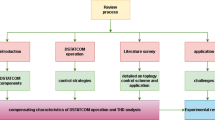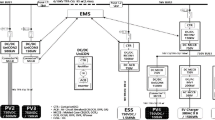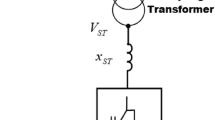Abstract
This research investigates the impact of renewable energy integration on blinder-based Out-Of-Step (OOS) relays, which protect synchronous generators from unstable power swings. Challenges arise in distinguishing stable and unstable power swings due to fault ride-through (FRT), control operation, and weak inertia of renewable sources. Modified blinder-based OOS relays are analyzed in MATLAB using a modified Kundur two-area system. Findings show that high renewable energy penetration increases the likelihood of blinder-based relay failures during transient and small-signal stability incidents. The study also explores the effects of power swings on neighboring and remote OOS relays. Additionally, it examines the interaction between synchronous generators and renewable sources, and their impact on system stability during FRT. Modifications to single and double blinder-based OOS relays and their synchronization are proposed. The study concludes that the modified relay protection functions as inoperable for stable swings and operable for unstable swings, enhancing overall relay performance.












Similar content being viewed by others
References
Rao JG, Pradhan AK (2017) Supervising distance relay during power swing using synchrophasor measurements. IET Gener Transm Distrib 11(17):4136–4145
Lavand SA, Soman SA (2016) Predictive analytic to supervise zone 1 of distance relay using synchrophasors. IEEE Trans Power Deliv 31(4):1844–1854
Shimpi KS., Student ME, Jain AM (2017) Power swing detection, blocking and unblocking logic in distance relay. In: 2017 International conference on computing methodologies and communication (ICCMC), pp 904–908
Central Electricity Regulatory Commission (2012) Grid disturbance on 30th July 2012 and grid disturbance on 31st July 2012. Available: http://cercind.gov.in/2012/orders/Final_Report_Grid_Disturbance.pdf
Warathe S, Patel RN (2015) Algorithm for power swing protection using DSP based numerical relay. In: 2015 2nd International Conference on signal processing and integrated networks, pp 762–767
Fang Y, Jia K, Zhu Z, Feng T, Yang Z, Liu B (2019) Adaptability analysis of distance protection on the transmission lines emanating from renewable power generators. In: 2019 IEEE innovative smart grid technologies–Asia (ISGT Asia), pp 275–279
Fang Y, Jia K, Yang Z, Li Y, Bi T (2019) Impact of inverter-interfaced renewable energy generators on distance protection and an improved scheme. IEEE Trans Ind Electron 66(9):7078–7088
Ren G, Liu J, Wan J, Guo Y, Yu D (2017) Overview of wind power intermittency: Impacts, measurements, and mitigation solutions. Appl Energy 204:47–65
Nimpitiwan N, Heydt GT, Ayyanar R, Suryanarayanan S (2007) Fault current contribution from synchronous machine and inverter based distributed generators. IEEE Trans Power Deliv 22(1):634–641
Hooshyar H, Baran ME (2013) Fault analysis on distribution feeders with high penetration of PV systems. IEEE Trans Power Syst 28(3):2890–2896
Rampurkar V, Pentayya P, Mangalvedekar HA, Kazi F (2016) Cascading failure analysis for indian power grid. IEEE Trans Smart Grid 7(4):1951–1960
Paudyal S, Ramakrishna G, Sachdev MS (2008) Out-of-step protection using the equal area criterion in time domain–SMIB and 3-machine case studies. In: TENCON 2008–2008 IEEE region 10 conference, pp 1–6
Kang D, Gokaraju R (2016) A new method for blocking third-zone distance relays during stable power swings. IEEE Trans Power Deliv 31(4):1836–1843. https://doi.org/10.1109/TPWRD.2016.2520394
Tekdemir IG, Alboyaci B (2017) A novel approach for improvement of power swing blocking and deblocking functions in distance relays. IEEE Trans Power Deliv 32(4):1986–1994
Sauhats A, Utans A, Biela-Dalidovicha E (2017) Equal area criterion and angle control-based out-of-step protection. In: 2017 IEEE 58th international scientific conference on power and electrical engineering of Riga technical university (RTUCON), pp 1–6. https://doi.org/10.1109/RTUCON.2017.8124752
Haddadi A, Kocar I, Karaagac U, Gras H, Farantatos E (2019) Impact of wind generation on power swing protection. IEEE Trans Power Deliv 34(3):1118–1128
Rezaei S (2019) Behavior of protective relays during sub synchronous resonance in transmission line and adaptation of generator out-of-step protection. IEEE Trans Ind Appl 55(6):5687–5698
Desai J, Makwana V (2020) Power swing blocking algorithm based on real and reactive power transient stability. Electric Power Compon Syst 48(16–17):1673–1683. https://doi.org/10.1080/15325008.2021.1906794
Desai JP, Makwana VH (2020) Phasor measurement unit incorporated adaptive out-of-step protection of synchronous generator. J Modern Power Syst Clean Energy 9(5):1–10
Jalilian A, Robinson DA (2023) A real-time setting-free synchronous generator out-of-step protection scheme based on voltage trajectory. IEEE Syst J 45:9824. https://doi.org/10.1109/JSYST.2023.3249824
Regulski P, Rebizant W, Kereit M, Herrmann H-J (2018) PMU-based generator out-of-step protection. IFAC-Pap 51(28):79–84
Camarillo-Penaranda JR, Celeita D, Gutierrez M, Toro M, Ramos G (2020) An approach for out-of-step protection based on swing center voltage estimation and analytic geometry parameters. IEEE Trans Ind Appl 56(3):2402–2408
Frimpong EA, Okyere PY, Asumadu J (2017) On-line determination of transient stability status using MLPNN. In: Proceeding IEEE PES power Africa, pp 23–27
Li Z, Hu C, Cui D, Wang Y, Zhu Y (2022) Out-of-step protection in generator based on intelligent identification of impedance trajectory. In: 2022 International conference on artificial intelligence and computer information technology (AICIT), Yichang, China, pp 1–4. https://doi.org/10.1109/AICIT55386.2022.9930321
Tealane M, Kilter J, Bagleybter O, Heimisson B, Popov M (2022) Out-of-step protection based on discrete angle derivatives. IEEE Access 10:78290–78305. https://doi.org/10.1109/ACCESS.2022.3193390
Desai JP, Makwana VH (2022) Modeling and implementation of power swing detection and out-of-step protection. J Inst Eng India Ser B 103:541–548. https://doi.org/10.1007/s40031-021-00679-2
Machowski J, Lubosny Z, Bialek JW, Bumby JR (2020) Power system dynamics: stability and control. Wiley, Hoboken
Donald R (2006) Protective relaying for power generation systems. CRC/Taylor & Francis, Boca Raton
I. C. Report (1973) Dynamic models for steam and hydro turbines in power system studies. IEEE Trans Power Appar Syst 92(6):1904–1915
Kundur P (1994) Power system stability and control. McGraw-Hill Education, New York
Liu G, Azizi S, Sun M, Popov M, Terzija V (2018) Performance of out-of-step tripping protection under renewable integration. J Eng 2018(15):1216–1222
Trevisan AS, El-Deib AA, Gagnon R, Mahseredjian J, Fecteau M (2018) Field validated generic EMT-type model of a full converter wind turbine based on a gearless externally excited synchronous generator. IEEE Trans Power Deliv 33(5):2284–2293
Lee D (1992) Recommended practice for excitation system models for power system stability studies IEEE® standard 421.5–1992. Energy Dev Power Gener Comm Power Eng Soc 95:96
IEEE Committee Report (1973) Dynamic models for steam and hydro turbines in power system studies. IEEE Trans Power Appar Syst 92(6):1904–1915
Author information
Authors and Affiliations
Contributions
JPD contributed to conceptualization, implementation, methodology, data curation, writing—original and final draft preparation, visualization, investigation, research and development, training, testing, reviewing, simulation, and result validation.
Corresponding author
Ethics declarations
Conflict of interest
The author declare no conflict of interest.
Additional information
Publisher's Note
Springer Nature remains neutral with regard to jurisdictional claims in published maps and institutional affiliations.
Appendix and nomenclature
Appendix and nomenclature
1.1 Appendix A1: Kundur two area system details
The system is made up of two analogous segments linked by a highly sensitive tie line. Each region has two generating units with 900 MVA and 20 kV ratings. The following are the generator limits in p.u. based on their rated MVA and KV base:
Generator Parameters: | Bsat = 9.6; Yt1 = 0.9; H = 6.5(G1 & G2) H = 6.175 (G3 & G4); KD = 0; Xd = 1.8; Xq = 1.7;Xl = 0.2;Xd' = 0.3. Xq' = 0.55; Xd'' = 0.25;Xq'' = 0.25; Ra = 0.0025. Td0' = 8.0 s; Tq0' = 0.4 s'; Td0'' = 0.03 s; Tq0'' = 0.05 s. Asat = 0.015 |
For each step-up transformer: | ZT = 0 + j0.15 pu on 900 MVA & 20/230 kV base. Off nominal ratio = 1.0 |
For Transmission line: | r = 0.0001pu/km; xL = 0.001pu/km; bC = 0.00175 pu/km and length = 220 km |
The system is operational, with region 1 exporting 400 MW to area 2, and generators parameters: | G1:P1 = 700 MW;Q = 185MVAr; ET = 1.03(20.2◦) G2:P2 = 700 MW;Q = 235MVAr; Et = 1.01(10.5◦) G3:P3 = 719 MW;Q = 176MVAr; Et = 1.03(6.8◦) G4:P4 = 700 MW;Q = 202MVAr; Et = 1.01(17.0◦) |
The following are the loads and reactive power provided by shunt capacitors on buses 7 and 9: | Bus 7: PL = 967 MW;QL = 100MVAr; QC = 200MVAr. Bus 9: PL = 1767 MW; QL = 100MVAr; QC = 350MVAr |
1.2 Appendix A2: Turbine, governor, and excitation system model’s details
Steam turbine and governor modeling parameters: | |
|---|---|
Regulator gain | 1 |
Permanent droop | 0.05 |
dead zone | 0 s |
Speed relay | 0.001 s |
servo-motor time constants | 0.15 s |
Gate opening limits | Vgmin = −0.1; Vgmax = 0.1; Gmin = 0; Gmax = 4.496 |
Speed | 3600 rpm |
Steam turbine time constants | T2 = 0 s; T3 = 10 s T4 = 3.3 s;T5 = 0.5 s |
Turbine torque fractions | F2 = 0;F3 = 0.36 F4 = 0.36; F5 = 0.28 |
Initial power | 0.7778 pu |
Excitation modeling data are as follows: | |
The low-pass filter time constant | 0.002 s |
Regulator gain and time constant | 200 and 0.001 s |
Exciter | Ke = 1 Te = 0 s |
Transient gain reduction | Tb = 0 s; Tc = 0 s |
Damping filter gain & time constant | Kf = 0; Tf = 0 s |
Regulator output limits & gain | Efmax = + 12.3, Efmin = −12.3, kp = 0 |
1.3 Appendix A3: Wind power source modeling as renewable source with usual notation
Fault ride through strategy | Mode:1 as Reactive power support, Mode:2 as zero power mode |
|---|---|
UVRT trigger constant, OVRT trigger constant, FRT band constant, FRT max time | 0.8, 1.2, 0.01, 5 s |
Proportional gains: kUVRT, kOVRT | 2, 2 |
Voltage protection parameters in p.u: Vmax, Vmaxdelay, Vmin, Vmindelay | 1.25, 0.1, 0.8,5 |
Frequency protection parameters in p.u.: fmax, fmaxdelay, fmin, fmin delay | 1.05, 1, 0.95, 1 |
Maximum Power of 1 unit, Total unit in W1 | 2 MW, 50 |
1.4 List of symbols
G1, G2; G3; G4 | Generator 1, generator 2, generator 3 and generator 4 respectively |
\(\theta 1,\theta 2;\theta 3;\theta 4\) | Rotor angle 1, rotor angle 2, rotor angle 3, rotor angle 4 respectively |
\(I_{{{\text{fl}}}}\) | Full load current |
\(Z_{{{\text{base}}}}\) | Base value of Impedance |
\(KV_{{{\text{base}}}}\) | Base value of KV of system |
\(B_{{{\text{g}}_{1} }}\) | Generator bus 1 |
\(B_{{{\text{g}}_{2} }}\) | Generator bus 2 |
\(B_{{{\text{g}}_{3} }}\) | Generator bus 3 |
\(B_{{{\text{g}}_{4} }}\) | Generator bus 4 |
\({\text{MVA}}_{{{\text{base}}}}\) | MVA base value of the system |
R | Resistance in ohm |
X | Reactance in ohm |
W1, W2, W3, W4 | Wind generator 1, wind generator 2, wind generator 3, wind generator 4 respectively |
tcr | Critical Clearing time |
Td1 | Delay time 1 between Zmho and inner blinder |
Td2 | Delay time 2 for between right to left blinder ad vice versa |
Td3 | Delay time between two right or left blinder in DB |
\(\delta\) | Power angle between generator and load |
I | Current from the stator of the generator during out of step conditions |
Imax | Maximum current through generator stator |
t | Simulation run time |
VPOC | Voltage at the point of common coupling |
PPOC | Active power at the point of common coupling |
QPOC | Reactive power at the point of common coupling |
1.5 List of abbreviations
CCT | Critical clearing time |
CT | Current transformer |
DB | Double blinder |
EAC | Equal area criteria |
EMTDC | Electromagnetic transients including DC |
LVRT | Low voltage ride through |
GU | Generator transformer unit |
HV | High voltage |
OOS | Out of step |
PT | Potential transformer |
POC | Point of common coupling |
PSCAD | Power system computer-aided design |
SB | Single blinder |
MATALB | Math works laboratory |
SIMULINK | MATLAB-based graphical programming environment for modeling |
Rights and permissions
Springer Nature or its licensor (e.g. a society or other partner) holds exclusive rights to this article under a publishing agreement with the author(s) or other rightsholder(s); author self-archiving of the accepted manuscript version of this article is solely governed by the terms of such publishing agreement and applicable law.
About this article
Cite this article
Desai, J.P. Modified blinder-based out-of-step relays with renewable integration. Electr Eng 106, 493–507 (2024). https://doi.org/10.1007/s00202-023-01993-2
Received:
Accepted:
Published:
Issue Date:
DOI: https://doi.org/10.1007/s00202-023-01993-2




